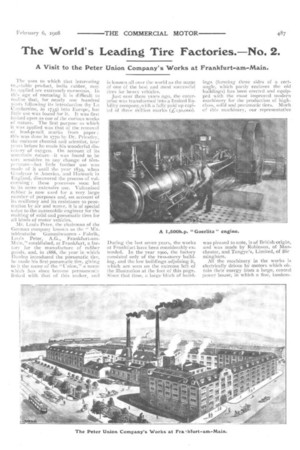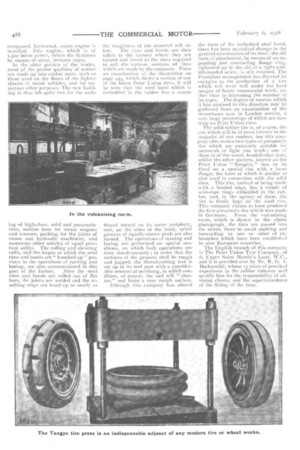The World's Leading Tire Factories. No. 2.
Page 5

Page 6

If you've noticed an error in this article please click here to report it so we can fix it.
A Visit to the Peter Union Company's Works at Frankfurt-am-.Main.
The uses to which that interesting C•.4itable product, India rubber, may :tpplied are extremely numerous. In this age of motoring it is difficult to realise that, for nearly one hundred years following its introduction (by Ea Condamine, in 1735) into Europe, but little use was found for it. It was first looked upon as one of the curious works of nature. The first purpose to which it \vas applied was that of the removal of lead-pencil marks from paper : this was dune in 1770 bv Dr. Priestley, the eminent chemist and scientist, four years before he made his wonderful diss rotary of oxygen. On account of its uncertain nature -it was found to be very sensitive to any change of t6rnpe:-7tture—but little further use was made of it until the year 1839, when Goodyear in America, and 1-kincock in England, discovered the process of vulcculising : these processes soon led to its more extensive use. Vulcanised rubber is now used for a very large number of purposes and, on account of Its resiliency and its resistance to penetration by air and water, it is of special value to the automobile engineer for the makingof solid and pneumatic tires for all kinds of motor vehicles, Mr. Louis Peter, the chairman of the German company known as the " Mitteldeutsche Gununiwaaren Eabrik, Louis Peter, A.G., Frankfurt-aroMain," established, at Frankfurt, a factory for the manufacture of rubber goods, and, in 1888, the year in which Dunlop introduced the pneumatic tire, he made his first pneumatic tire, giving to it the name of the "Union," a name which has since become permanenEy linked with that of Ibis maker, and
is known all over the world as the name of one of the best and most successful tires for heavy vehicles, Just over three years ago, the enterprise was transformed into a limited liability company,with a fully paid up capiml of three million marks (.1:15o,000).
During the last seven years, the works at Frankfurt have been considerably extended. In the year two, the factory consisted only of the two-storey build-. ing,, and the low buildings adjoining it, which are seen on the extreme left of the illustration at the foot of this page. Since that time, a large block of build lags (formingthree sides of a rectangle, which partly encloses the old buildings) has been erected and equipped with the most improved modern machinery for the production of highclass, solid and pneumatic tires. Much of [his machinery, our representative was pleased to note, is of British origin, and was made by Robinson, of Manchester, and Tangye's, Limited, of Bir mingham.
All the machinery in the works is electrically driven by motors which obtain their energy from a large, central power house, in which a -fine, tandem
compound, horizontal, steam engine is installed. This engine, which is of 1,5,00 horse power, drives ihe dynamos by means of stout, hempen ropes.
In the older portico of the works, most of the poorer qualities of rubber are made up into rubber mats, such as those used on the floors Of the lighter classes of motor vehicles, and for numerous other purposes. The new building is thus left quite free for the mak lug of high-class, solid and pneumatic tires, suction hose for steam wagons and tractors, packing for the joints of steam and hydraulic machinery, and numerous other articles of equal practieal utility. The rolling and shearing mills, and the forges at which the steel rims and bands are " knocked up " previous, to the operations of turning and boring, are also accommodated in this part of the factory. After the steel rims and bands are rolled out of flat bars, the joints are welded and the resulting rings are trued up as nearly as the roughness of the material will al low. The rims and bands are then taken to the turnery where they are turned and bored to the sizes required to suit the various sections of tires which are made bv the company. From an examination of the illustration on page 493, which shows a section of one of the latest Peter Union tires, it will be seen that the steel band which is embedded in the rubber has it coarse thread turned on its outer periphery, and, on the sides of the hand, spiral grooves of equally-coarse pitch are also turned. The operations of turning and boring are performed on special machines, on which both operations are done simultaneously ; in order that the surfaces of the grooves shall be rough and jagged, the thread-cutting tool is set up in its tool post with a considerable amount of overhang, in which condition, of course, the tool will " chatter," and leave a very rotigh surface.
Although this company has altered the form of the embedded steel hand, there has been no radical change in the general construction of its tires : the old form of attachment, by means of an expanding and contracting flange ring, tightened up by the aid of a right-andleft-handed screw, is still retained. The Frankfurt management has directed it; energies to the production of a time which will wear well under the hard usages of heavy commercial work, rather than to increasing the number of its types. The degree of success which it has attained in this direction may he gathered from an examination of the motorbuses now in London service, a very large percentage of which are running on Peter I.7nion tires.
The solid rubber tire is, of course, the one which will be of most interest to the majority of our readers, but this coinpay also makes two types of pneuma:ic tire which are eminently suitable fur molorcab or light van work : one of these is of the usual, beaded-edge type, whilst the other pattern, known as the Peter Union " Simplex," has to be fitted on a special rim with a loose flange, the form of which is similar to that used in connection with the solid Iires. This Lire, instead of being made with a beaded edge, has a couple of wire-rope rings embedded in the rubber, and, by the agency of these, the tire is firmly kept on the steel rim. This company claims to have produced the first pneumatic tire which was made in Germany. From the vulcanising, room, which is shown in the above photograph, the tires are passed into the stores, there to await packing and forwarding to one or other of the branches which have been established in nine European countries.
The English branch of this company is The Peter Union Tyre Company, of 6, Upper Saint Martin's Lane, W.C., and it is presided over by Mr. R. 0. A. Bockemiihl, whose 13 years of practical experience in the rubber industry welt qualify him for the responsibility of advising clients, and the superintendence of the fitting of the tires.


















